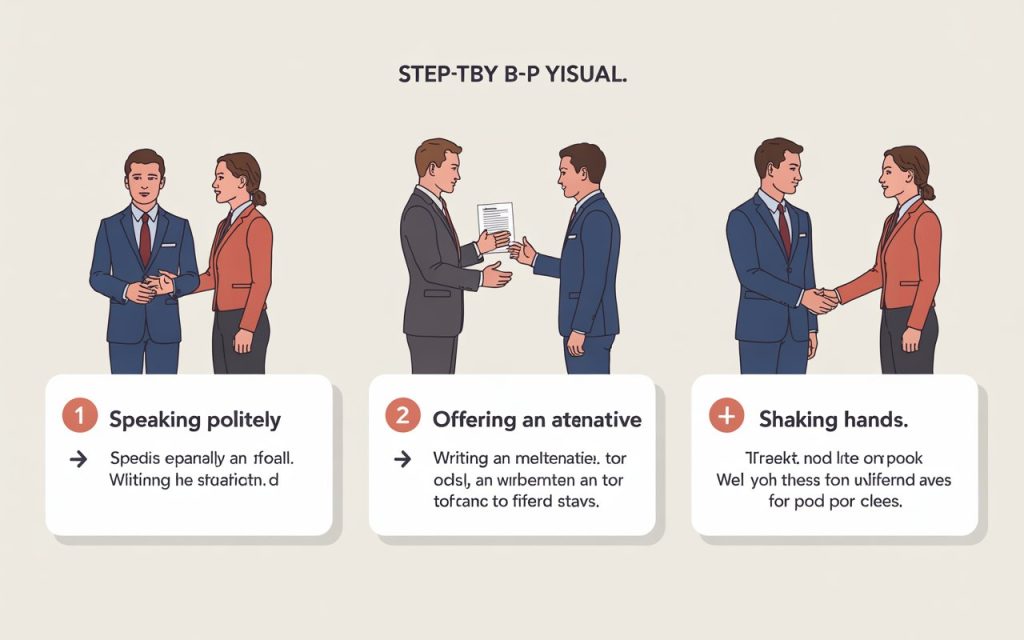Master Saying No Without Guilt: The Ultimate Guide

INTRODUCTION
Saying no is often seen as uncomfortable or even risky, but it is one of the most empowering skills you can develop for both your personal and professional life. The ability to say no is not just about declining requests—it’s about protecting your time, energy, and well-being, and ensuring that your commitments align with your true priorities. Many people feel pressured to agree to things out of fear of disappointing others, damaging relationships, or missing out on opportunities. However, always saying yes can lead to burnout, resentment, and a loss of control over your own life.
Learning to say no is a sign of self-respect and maturity. It allows you to set healthy boundaries, which are essential for maintaining mental health, reducing stress, and building genuine, respectful relationships. When you say no appropriately, you teach others to value your time and decisions, and you model the importance of self-care. In fact, saying no can actually strengthen relationships by fostering honesty and mutual understanding, rather than allowing unspoken resentment to build up over time.

In the workplace, the ability to say no is a critical skill that can prevent overcommitment and protect your professional reputation. By declining tasks or projects that don’t align with your goals or capacity, you preserve your energy for high-priority work and demonstrate your commitment to delivering quality results. In negotiations, knowing when to walk away from a bad deal is often the key to achieving better outcomes, as it shows confidence in your worth and your willingness to wait for terms that truly benefit you.
Ultimately, saying no is not about being selfish or unkind—it’s about making intentional choices that support your growth, happiness, and success. By mastering this skill, you open the door to a more balanced, fulfilling, and empowered life.
Why Saying No Matters
Saying no is not just about turning down requests; it’s about setting boundaries and protecting your interests. Every agreement you make—whether formal or informal—affects your commitments, finances, and reputation. If you say yes to everything, you risk:
- Burnout: Overcommitting leads to exhaustion and decreased productivity.
- Financial Loss: Accepting unfavorable terms can hurt your income or business.
- Damaged Reputation: Failing to deliver because you took on too much can harm your professional image.
- Loss of Control: You lose the ability to prioritize what truly matters to you.
Real-Life Examples
- Freelancers: Taking on every project can mean missing deadlines, producing lower-quality work, and losing clients.
- Employees: Always agreeing to extra work can lead to resentment, stress, and being overlooked for promotions.
- Business Owners: Accepting every partnership may stretch resources thin, dilute your brand, and create confusion.
Saying no allows you to focus on your priorities, deliver quality, and maintain healthy relationships.
The Psychology Behind Saying No

Guilt and People-Pleasing
Many people feel guilty when they say no because they want to be liked or fear disappointing others. This guilt can lead to:
- Agreeing to things you don’t want or can’t handle
- Building up resentment and stress
- Lowered self-esteem
How to Overcome Guilt:
- Remind yourself that your needs and limits are valid.
- Practice self-affirmation: “It’s okay to prioritize my well-being.”
- Understand that you can’t please everyone—and that’s healthy.
Fear of Conflict and Rejection
Saying no can feel confrontational, especially in cultures or environments where harmony is valued. This fear can cause you to:
- Avoid necessary conversations
- Agree to unfair or unclear terms
- Remain in uncomfortable situations
How to Manage Fear:
- Use calm, polite language to reduce tension.
- Prepare for possible reactions and rehearse your response.
- Focus on facts and your own needs, not just the other person’s emotions.
Building Self-Respect and Assertiveness
Saying no is an act of self-care and self-respect. Assertiveness means expressing your needs clearly and respectfully, not aggressively.
How to Build Assertiveness:
- Use assertive body language: maintain eye contact, stand tall, and speak clearly.
- Set clear boundaries and stick to them.
- Use “I” statements: “I am unable to commit to this right now.”
Overcoming Anxiety and Fear of Missing Out (FOMO)
Anxiety about saying no often comes from the fear of missing opportunities or being excluded.
How to Cope:
- Reflect on past situations where saying no led to better outcomes.
- Use relaxation techniques, such as deep breathing, before difficult conversations.
- Remind yourself: every “no” creates space for better opportunities.
Practical Steps to Say No

Step-by-Step Guide
- Be Clear and Direct:
Use straightforward language. Example: “I’m unable to agree to these terms at this time.” Avoid vague responses that may cause confusion. - Stay Polite and Professional:
Thank the other party for the offer before declining. Example: “Thank you for thinking of me.” - Provide a Brief Reason:
You don’t need to over-explain. Example: “This doesn’t fit my current priorities.” If pressed, repeat your reason without elaborating. - Offer Alternatives When Possible:
Suggest a different timeline, terms, or refer someone else. Example: “I can’t take this on now, but I can recommend a colleague.” - Use Written Communication:
For contracts or important agreements, say no in writing to keep a clear record. This avoids misunderstandings and provides documentation if needed. - Follow Up:
If the other party is disappointed, follow up with a polite message to maintain the relationship.
Sample Phrases for Every Situation
- “I’m currently at capacity and can’t take on new work.”
- “This project isn’t the right fit for me at this time.”
- “I need more clarity before I can commit to this.”
- “The terms don’t meet my expectations for this work.”
- “Can we put this in writing for clarity?”
- “I need some time to review before I decide.”
- “This doesn’t align with my business values.”
- “I have prior commitments and can’t take this on.”
- “This is outside my area of expertise.”
- “I’m not comfortable with these terms.”
Practice Makes Perfect
- Role-Play: Practice saying no with a friend or colleague in different scenarios.
- Mirror Exercise: Practice your tone and body language in front of a mirror.
- Draft Emails: Write out sample refusal emails for common situations and review them for clarity and professionalism.
Legal and Contractual Considerations

Reading and Understanding Terms
- Always read the entire contract before agreeing.
- Look for hidden clauses, penalties, or obligations that may not be in your favor.
- If anything is unclear, ask for clarification or request changes.
Knowing Your Rights and Cooling-Off Periods
- Some contracts allow a cooling-off period, giving you time to reconsider after signing.
- Know the laws in your region regarding contract cancellation and consumer protection.
Common Legal Pitfalls and How to Avoid Them
- Signing Under Pressure: Take your time; never sign on the spot.
- Not Reading the Fine Print: Read every section, especially payment and termination clauses.
- Ignoring Jurisdiction Clauses: Know which laws apply to the contract.
- Overlooking Renewal Terms: Check for automatic renewals or extensions.
- Unclear Deliverables: Ensure all expectations are spelled out.
- No Exit Clause: Make sure you can leave the agreement if needed.
- One-Sided Penalties: Negotiate fair risk-sharing terms.
- Verbal Agreements Only: Get everything in writing for clarity and proof.
When to Seek Legal Advice
- If the contract involves large sums of money or long-term commitments.
- If you don’t understand any part of the agreement.
- If the other party is pressuring you to sign quickly.
- If you see red flags or feel uncomfortable.
Recognizing When to Say No

Red Flags in Agreements
- No written agreement
- Unclear deliverables or expectations
- One-sided penalties or risks
- No exit clause or termination option
- Unreasonable deadlines or demands
- Vague or delayed compensation terms
- Pressure to sign immediately
- Conflicts with your values or ethics
Protecting Your Values and Goals
- Only accept agreements that align with your personal or business objectives.
- Don’t compromise on ethics or standards for short-term gain.
Assessing Workload and Capacity
- Evaluate your current commitments before agreeing to new work.
- Use a workload tracker or planner to visualize your capacity.
Financial and Ethical Boundaries
- Never accept terms that put your finances or integrity at risk.
- Say no to projects that conflict with your ethical standards.
Handling Pushback and Pressure

Dealing with Emotional Reactions
- Stay calm and firm in your decision.
- Acknowledge the other person’s feelings, but don’t let them sway you.
Maintaining Professionalism
- Keep your language respectful, even if the other party is upset.
- Don’t engage in arguments or personal attacks.
Reframing the Conversation
- Focus on your needs and boundaries, not the other person’s disappointment.
- Offer to revisit the conversation later if appropriate.
Example Responses to Pushback
- “I appreciate your position, but I can’t commit right now.”
- “I have to be fair to my other commitments.”
- “I understand, but I must prioritize my workload.”
- “Thank you, but it’s not the right fit for me.”
- “I have to make the best choice for my situation.”
Tips to Avoid Guilt and Build Confidence

Mindset Shifts
- Remind yourself that saying no is a right, not a privilege.
- Focus on long-term benefits, not short-term discomfort.
Building Positive Habits
- Practice saying no in low-stakes situations.
- Celebrate each time you set a healthy boundary.
Reflecting on Outcomes
- After saying no, note how it improved your workload, mood, or relationships.
- Use positive outcomes to reinforce your confidence.
Advanced Strategies for Saying No

The “Sandwich” Technique
- Start with a positive comment, deliver your refusal, end with another positive.
- Example: “Thank you for the offer. I can’t take this on right now, but I appreciate you thinking of me.”
Setting Clear Policies
- If you’re a business owner, create clear guidelines for what you accept or decline.
- Share these policies with clients and partners to set expectations.
Documentation and Written Communication
- Keep records of all communications related to agreements and refusals.
- Use email templates for common scenarios to save time and ensure consistency.
Negotiation Tactics
- Sometimes, a “no” can open the door to better terms.
- Use your refusal as leverage to negotiate for what you really want.
Scenarios, Responses, and Alternatives
| Scenario | Why Say No? | Sample Response | Alternative Offered | Potential Risks if You Say Yes | Long-Term Benefit of Saying No |
|---|---|---|---|---|---|
| Overloaded with work | Prevent burnout | “I’m at full capacity and can’t take more right now.” | “I can refer you to a colleague.” | Missed deadlines, poor quality | Maintained quality, less stress |
| Unclear contract terms | Avoid misunderstandings | “I need more details before I can agree.” | “Can you clarify the deliverables?” | Disputes, unmet expectations | Clearer agreements, fewer conflicts |
| Unfair payment | Protect your value | “The rate doesn’t match my expectations.” | “I’m open to discussing the rate.” | Underpayment, resentment | Fair compensation, satisfaction |
| Rushed decision | Avoid pressure, make informed choice | “I need more time to review the contract.” | “Can we set a later deadline?” | Overlooked risks, regret | Informed decisions, fewer regrets |
| Conflicting values | Stay true to your principles | “This doesn’t align with my business values.” | “Let’s discuss other opportunities.” | Reputational harm, discomfort | Integrity, stronger brand |
| Not enough expertise | Avoid poor results | “This is outside my area of expertise.” | “I can recommend someone else.” | Mistakes, damaged reputation | Professional growth, credibility |
| Unreasonable deadlines | Prevent stress and failure | “The timeline is too tight for quality work.” | “Can we extend the deadline?” | Rushed work, missed deadlines | Better results, trust from clients |
| No exit clause | Avoid being trapped | “I’d like to discuss a fair exit clause.” | “Can we add a termination option?” | Inability to leave bad agreements | Flexibility, reduced risk |
| One-sided penalties | Ensure fairness | “Can we review the penalty terms for balance?” | “Let’s discuss risk-sharing.” | Financial loss, unfair blame | Fairer contracts, better relationships |
| Vague compensation terms | Ensure payment | “Can you specify the payment schedule?” | “Let’s clarify the terms.” | Late or missed payments | Reliable income, financial stability |
| Pressure to sign immediately | Avoid hasty decisions | “I need time to review before signing.” | “Let’s schedule a follow-up.” | Missing important details, regret | Thoughtful choices, better outcomes |
| Already committed | Avoid overbooking | “I have prior commitments and can’t take this on.” | “Maybe next time.” | Overwork, poor performance | Balanced workload, reliability |
| Not comfortable with terms | Protect your interests | “I’m not comfortable with these terms.” | “Can we review the agreement?” | Unhappiness, legal issues | Peace of mind, stronger agreements |
| Unclear project goals | Avoid confusion | “Can we clarify the project objectives?” | “Let’s set a meeting to discuss.” | Wasted effort, missed targets | Clear direction, better outcomes |
| No written agreement | Avoid disputes | “Can we put this in writing?” | “Let’s draft a simple contract.” | Hard to enforce, misunderstandings | Legal protection, clarity |
| Unethical requests | Protect your reputation | “I’m not comfortable with this request.” | “Let’s find a compliant solution.” | Legal or ethical trouble | Integrity, trustworthiness |
| Unreasonable expectations | Maintain balance | “I can’t meet these expectations.” | “Let’s adjust the scope.” | Burnout, dissatisfaction | Sustainable workload, satisfaction |
| Poor communication | Prevent issues | “I need better communication to proceed.” | “Can we set regular updates?” | Misunderstandings, errors | Smoother collaboration, fewer mistakes |
| Lack of resources | Ensure quality | “I don’t have the resources for this project.” | “Let’s discuss support options.” | Incomplete work, stress | Realistic planning, successful delivery |
| Conflicting schedules | Avoid stress | “My schedule doesn’t allow for this.” | “Can we find a later date?” | Missed deadlines, stress | Better time management, less pressure |
Quotes
“The difference between successful people and really successful people is that really successful people say no to almost everything.”
— Warren Buffett
“You have to decide what your highest priorities are and have the courage—pleasantly, smilingly, non-apologetically—to say ‘no’ to other things.”
— Stephen Covey
“Half of the troubles of this life can be traced to saying yes too quickly and not saying no soon enough.”
— Josh Billings
“Saying no can be the ultimate self-care.”
— Claudia Black
“When you say yes to others, make sure you are not saying no to yourself.”
— Paulo Coelho
“No is a complete sentence.”
— Anne Lamott
“Daring to set boundaries is about having the courage to love ourselves, even when we risk disappointing others.”
— Brené Brown
“Let today mark a new beginning for you. Give yourself permission to say NO without feeling guilty, mean, or selfish.”
— Stephanie Lahart
Tips
- Be Clear and Direct:
Use straightforward language to communicate your decision. Avoid vague responses. - Stay Polite and Professional:
Always thank the person for the offer or opportunity before declining. - Provide a Brief Reason (If Needed):
You don’t need to over-explain. A simple statement about your current priorities is enough. - Offer Alternatives When Possible:
Suggest a different timeline, terms, or refer someone else who might be able to help. - Use Written Communication for Important Matters:
For contracts or significant agreements, put your refusal in writing to avoid misunderstandings. - Follow Up to Maintain Relationships:
If the other party is disappointed, send a polite follow-up message to preserve goodwill. - Practice Assertive Body Language:
Maintain eye contact, use a steady voice, and avoid excessive apologies. - Reflect on Positive Outcomes:
After saying no, notice how it benefits your workload, mood, or relationships. - Remind Yourself That Saying No Is Your Right:
Setting boundaries is a sign of self-respect and maturity. - Stay Calm and Firm in the Face of Pushback:
Repeat your decision if needed and avoid being drawn into arguments.
Frequently Asked Questions (FAQs)

1. Why do I feel so guilty when I say no
Guilt often comes from a desire to please others, fear of conflict, or cultural beliefs that saying no is rude or selfish. Recognizing that your needs are valid can help reduce this guilt.
2. Can saying no damage my relationships
When done respectfully, saying no actually builds healthier relationships. It sets clear boundaries and encourages mutual respect, rather than fostering resentment or being taken for granted.
3. How can I say no without sounding rude
Be polite and direct. Thank the person for the opportunity, give a brief reason if you wish, and offer alternatives if possible. Kindness and clarity go a long way.
4. What if my boss or a senior colleague asks me to do something I can’t handle
Communicate honestly about your current workload and capacity. Suggest priorities or negotiate deadlines to show you are committed but realistic about what you can deliver.
5. How does saying no benefit my mental health
It reduces stress, prevents burnout, and allows you to focus on what truly matters to you, supporting your overall well-being and resilience.
6. Is it okay to say no without giving a reason
Yes, you are not obligated to justify every refusal. A simple, polite “I’m unable to commit to this right now” is often enough.
7. What should I do if someone reacts badly to my refusal
Stay calm and firm. Acknowledge their feelings, but remember that setting boundaries is your right. If necessary, repeat your decision and avoid being drawn into arguments.
8. Can saying no help my career
Absolutely. It prevents overcommitment, protects your professional reputation, and helps you focus on high-value work, making you more effective and respected in your field
Conclusion
Mastering the art of saying no is essential for protecting your interests, maintaining boundaries, and building healthy, respectful agreements. By understanding the psychology, using practical steps, and recognizing when to say no, you empower yourself to make better decisions for your life and business.




